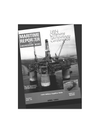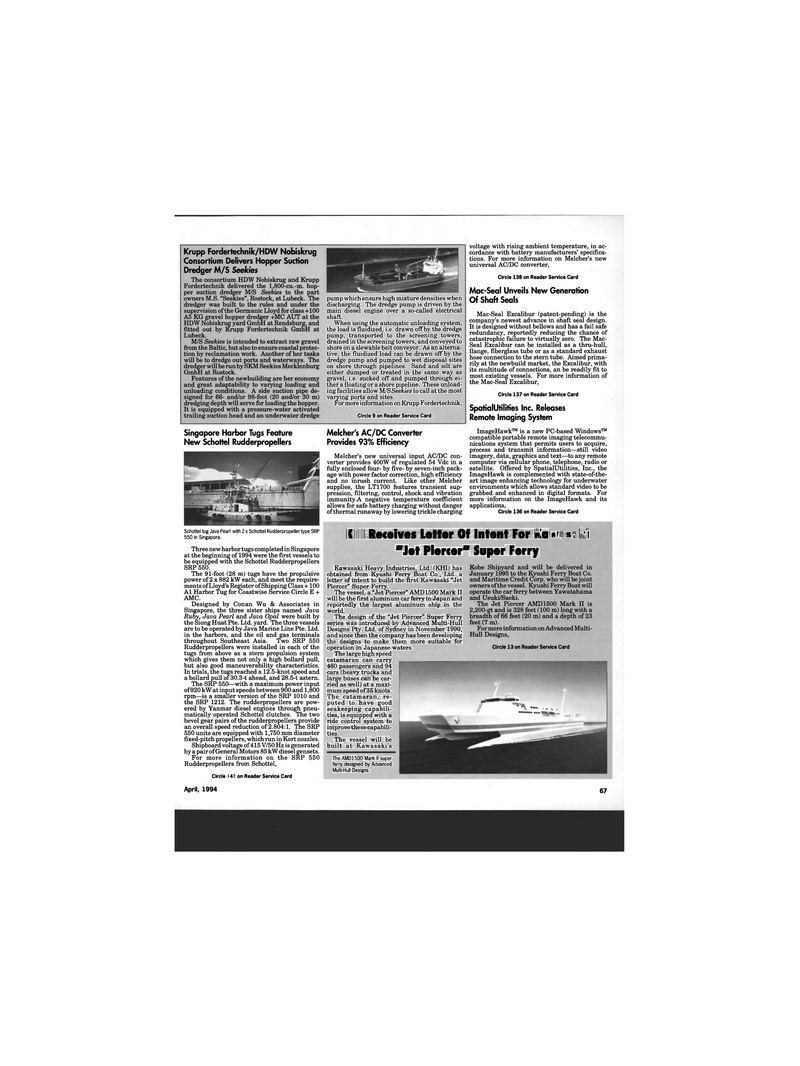
Page 81: of Maritime Reporter Magazine (April 1994)
Read this page in Pdf, Flash or Html5 edition of April 1994 Maritime Reporter Magazine
Krupp Fordertechnik/HDW Nobiskrug
Consortium Delivers Hopper Suction
Dredger M/S Seekies
The consortium HDW Nobiskrug and Krupp
Fordertechnik delivered the l,800-cu.-m. hop- per suction dredger M/S Seekies to the part owners M.S. "Seekies", Rostock, at Lubeck. The dredger was built to the rules and under the supervision of the Germanic Lloyd for class +100
A5 KG gravel hopper dredger +MC AUT at the
HDW Nobiskrug yard GmbH at Rendsburg, and fitted out by Krupp Fordertechnik GmbH at
Lubeck.
M/S Seekies is intended to extract raw gravel from the Baltic, but also to ensure coastal protec- tion by reclamation work. Another of her tasks will be to dredge out ports and waterways. The dredger will be run by SKM Seekies Mecklenburg
GmbH at Rostock.
Features ofthe newbuilding are her economy and great adaptability to varying loading and unloading conditions. A side suction pipe de- signed for 66- and/or 98-foot (20 and/or 30 m) dredging depth will serve for loading the hopper.
It is equipped with a pressure-water activated trailing suction head and an underwater dredge
Singapore Harbor Tugs Feature
New Schottel Rudderpropellers pump which ensure high mixture densities when discharging. The dredge pump is driven by the main diesel engine over a so-called electrical shaft.
When using the automatic unloading system, the load is fluidized, i.e. drawn off by the dredge pump, transported to the screening towers, drained in the screening towers, and conveyed to shore on a slewable belt conveyor. As an alterna- tive, the fluidized load can be drawn off by the dredge pump and pumped to wet disposal sites on shore through pipelines. Sand and silt are either dumped or treated in the same way as gravel, i.e. sucked off and pumped through ei- ther a floating or a shore pipeline. These unload- ing facilities allow M/S Seekies to call at the most varying ports and sites.
For more information on Krupp Fordertechnik,
Circle 9 on Reader Service Card
Melcher's AC/DC Converter
Provides 93% Efficiency
Melcher's new universal input AC/DC con- verter provides 400W of regulated 54 Vdc in a fully enclosed four- by five- by seven-inch pack- age with power factor correction, high efficiency and no inrush current. Like other Melcher supplies, the LT1700 features transient sup- pression, filtering, control, shock and vibration immunity.A negative temperature coefficient allows for safe battery charging without danger of thermal runaway by lowering trickle charging voltage with rising ambient temperature, in ac- cordance with battery manufacturers' specifica- tions. For more information on Melcher's new universal AC/DC converter,
Circle 138 on Reader Service Card
Mac-Seal Unveils New Generation
Of Shaft Seals
Mac-Seal Excalibur (patent-pending) is the company's newest advance in shaft seal design.
It is designed without bellows and has a fail safe redundancy, reportedly reducing the chance of catastrophic failure to virtually zero. The Mac-
Seal Excalibur can be installed as a thru-hull, flange, fiberglass tube or as a standard exhaust hose connection to the stern tube. Aimed prima- rily at the newbuild market, the Excalibur, with its multitude of connections, an be readily fit to most existing vessels. For more information of the Mac-Seal Excalibur,
Circle 137 on Reader Service Card
SpatiaIUtiIities Inc. Releases
Remote Imaging System
ImageHawk™ is a new PC-based Windows™ compatible portable remote imaging telecommu- nications system that permits users to acquire, process and transmit information—still video imagery, data, graphics and text—to any remote computer via cellular phone, telephone, radio or satellite. Offered by SpatialUtilities, Inc., the
ImageHawk is complemented with state-of-the- art image enhancing technology for underwater environments which allows standard video to be grabbed and enhanced in digital formats. For more information on the ImageHawk and its applications,
Circle 136 on Reader Service Card
Schottel tug Java Pearl with 2 x Schottel Rudderpropeller type SRP 550 in Singapore.
Three new harbor tugs completed in Singapore at the beginning of 1994 were the first vessels to be equipped with the Schottel Rudderpropellers
SRP 550.
The 91-foot (28 m) tugs have the propulsive power of 2 x 882 kW each, and meet the require- ments of Lloyd's Register of Shipping Class + 100
A1 Harbor Tug for Coastwise Service Circle E +
AMC.
Designed by Conan Wu & Associates in
Singapore, the three sister ships named Java
Ruby, Java Pearl and Java Opal were built by the Siong Huat Pte. Ltd. yard. The three vessels are to be operated by Java Marine Line Pte. Ltd. in the harbors, and the oil and gas terminals throughout Southeast Asia. Two SRP 550
Rudderpropellers were installed in each of the tugs from above as a stern propulsion system which gives them not only a high bollard pull, but also good maneuverability characteristics.
In trials, the tugs reached a 12.5-knot speed and a bollard pull of 30.3-t ahead, and 28.5-t astern.
The SRP 550—with a maximum power input of920 kW at input speeds between 900 and 1,800 rpm—is a smaller version of the SRP 1010 and the SRP 1212. The rudderpropellers are pow- ered by Yanmar diesel engines through pneu- matically operated Schottel clutches. The two bevel gear pairs of the rudderpropellers provide an overall speed reduction of 2.804:1. The SRP 550 units are equipped with 1,750 mm diameter fixed-pitch propellers, which run in Kort nozzles.
Shipboard voltage of 415 V/50 Hz is generated by a pair of General Motors 85 kW diesel gensets.
For more information on the SRP 550
Rudderpropellers from Schottel,
Circle 342 on Reader Service Card
The AMD1500 Mark II super ferry designed by Advanced
Multi-Hull Designs.
Kill vUv/.M:!1') "Jet Piercer" Super Ferry
Kawasaki Heavy Industries, Ltd. (KHI) has obtained from Kyushi Ferry Boat Co., Ltd. a letter of intent to build the first Kawasaki "Jet
Piercer" Super Ferry.
The vessel, a "Jet Piercer" AMD 1500 Mark II will be the first aluminum car ferry in Japan and reportedly the largest aluminum ship in the world.
The design of the "Jet Piercer" Super Ferry series was introduced by Advanced Multi-Hull
Designs Pty. Ltd. of Sydney in November 1990, and since then the company has been developing the designs to make them more suitable for operation in Japanese waters.
The large high speed catamaran can carry 460 passengers and 94 cars (heavy trucks and large buses can be car- ried as well) at a maxi- mum speed of 35 knots.
The catamaran, re- puted to have good seakeeping capabili- ties, is equipped with a ride control system to improve these capabili- ties.
The vessel will be built at Kawasaki's
Kobe Shipyard and will be delivered in
January 1995 to the Kyushi Ferry Boat Co. and Maritime Credit Corp. who will be joint owners of the vessel. Kyushi Ferry Boat will operate the car ferry between Yawatahama and Usuki/Saeki.
The Jet Piercer AMD 1500 Mark II is 2,200-gt and is 328 feet (100 m) long with a breadth of 66 feet (20 m) and a depth of 23 feet (7 m).
For more information on Advanced Multi-
Hull Designs,
Circle 13 on Reader Service Card
April, 1994 67

 80
80

 82
82
